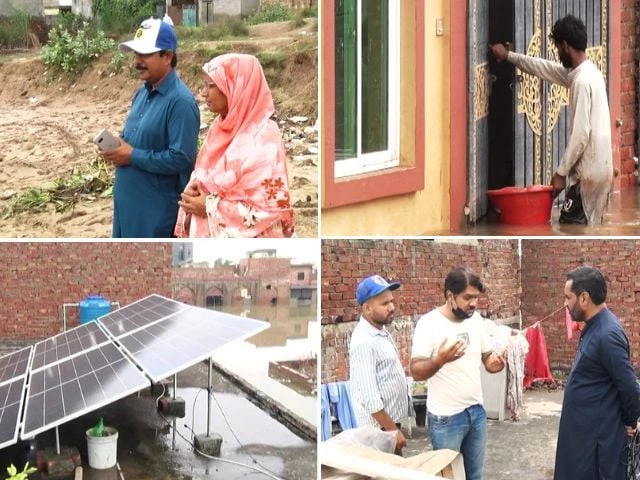The recent floods have ravaged crops, agricultural land and homes across Punjab, sweeping away from the lifetime of countless families, leaving them burdened with debt.
In a private housing community near Mohlanwal, Lahore, houses that were once built with hope are now abandoned – doors broken, walls collapsed and possessions destroyed by flooding water. For many residents, the destruction extends beyond loss of property to the crushing loans taken to build these homes.
Basharat Bibi remembered how just weeks earlier her dream house was completed.
“On August 10, the construction was complete. We were preparing for a prayer collection when the floods destroyed everything,” she said. Her husband, a Rickshaw driver, had been injured during the renovation work.

“We built this house with a loan from Akhuwat under the” Apni Chhat, Apna Ghar “scheme. The first installment was not even paid, and now we have nothing but debt.”
The story is the same for Nadeem Iqbal and his brothers who invested their savings in their home.

“We spent our life’s earnings on this house, but the flood flushed away all our dreams,” he said, pointing to the water still standing inside.
For Muhammad Jahangir, the water has disappeared, but destruction is back. Destroyed furniture, mud -cooked doors and broken appliances fill his home.
“When the flood came, the police evacuated everyone and did not let us take anything,” he said. On the roof, his mother tried to wipe his daughter’s dowry in the sun.

“We saved for years to buy this, but everything is destroyed,” she complained, adding that some items were stolen under the chaos.
Read: Punjab -Flights ignite Fear of Sindh Deluge
Jahangir said their solar inverter was also taken. “It was not only us. Many residents here suffer not only from the destruction of the flood, but also from thefts.”
“We ask Punjab Minister Maryam Nawaz to hear our plea.
According to Provincial Disaster Management Authority (PDMA), more than 3,300 villages in Punjab have been affected by floods in Ravi, Sutlej and Chenab Rivers. Estimated 3.36 million people have been affected, while nearly 1.3 million have been evacuated to safer areas.
For families with flood-affected, this tragedy is not just about destroyed houses, but about broken dreams, ruined dowry and futures buried under the rubble-when waiting for the state to step in and help them rebuild their lives.
Auxiliary efforts in flooded areas
The Pakistani Army, Civil Administration and other departments are sustained rescue and relief operations in flooded areas of South Punjab.
The protective dam at Ganda Singh Wala on the Sutlej River is broken while reporting a high-level flood at Head Sulemanki.
Read more: Moderate to heavy rain probably in Sindh from September 7
The protective dam at Ganda Singh Wala on the Sutlej River is broken, while a high-level flood has been reported at the head Sulemanki, which intensified the flood crisis over Punjab.
According to officials, twelve relief camps have been established in the suburbs near the river. In Sahiwal, 49 villages are flooded, with 30 camps set up to support displaced residents.
A high -level flood is also heading Sidhnai in Tehsil Kabirwala, where relief operations are ongoing in Tulamba, Mian Channu and Iqbal Nagar. Thousands of people, livestock and wheat stocks have been moved to safer places.
In Okara, free medical camps have been set up for flood victims, while additional camps have been created in ranking and head Muhammad Wala. In Tehsil Muzaffargarh and KOT Addu, precautions are reviewed jointly by the Pakistani Army and Civil Administration.
Relief work also continues in Kholra Point, Hasu Wali, Budhwana, Jhang and Chiniot, where hundreds of humans and animals have moved to safer areas. The Pakistani Army has established several relief camps and secured supplies of food, clothing and medicine, while providing free medical facilities to those affected.
The crisis has worsened after India’s release of large amounts of water in sutlej, causing high warnings in at least nine districts in Punjab in the midst of fear that fresh influx could aggravate the already “extremely high flooding situation”.



